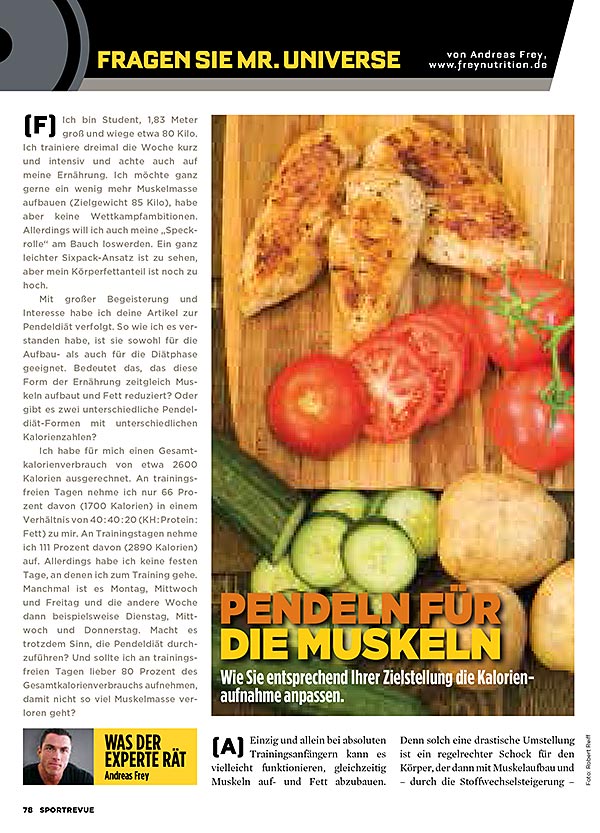COLUMN 76 |
COMMUTING FOR THE MUSCLES

HOW YOU CAN APPROPRIATELY DIVIDE YOUR CALORIE INTAKE ACCORDING TO YOUR GOALS USING THE COMMUTER DIET.
I have been following your articles on the pendulum diet with great enthusiasm and interest. As far as I understand, it is suitable for both the building phase and the diet phase. Does that mean that this form of diet builds muscle and reduces fat at the same time? Or are there two different types of pendulum diet with different calorie counts?
I have calculated that my total calorie consumption is around 2600 calories. On days when I don't train, I only consume 66 percent of that (1700 calories) in a ratio of 40:40:20 (carbs:protein:fat). On days when I train, I consume 111 percent of that (2890 calories). However, I don't have any set days when I go to train. Sometimes it's Monday, Wednesday and Friday and the other week, for example, Tuesday, Wednesday and Thursday. Does it still make sense to do the commuter diet? And should I consume 80 percent of my total calorie consumption on days when I don't train so that I don't lose so much muscle mass?
ANSWER

I recommend a build-up phase of eight to twelve weeks. You can also extend the duration to 14 to 16 weeks if you see steady progress. However, if you don't see any further muscle gain after twelve weeks, it's time for a diet phase. You should allow six to eight weeks for this. If you put on a little fat during the build-up period, that's not a problem. The diet phase is all about burning that fat...
Based on your body weight, you calculate a basal metabolic rate of around 1900 calories. If you do moderately strenuous work, you should choose a PAL factor (= Physical Activity Level) of 1.3. Adding the digestive loss (0.1) gives you a multiplier of 1.4. You therefore need to consume 2700 calories per day to maintain your weight - i.e. neither gain nor lose weight.To build muscle, you increase this calorie value by 500 calories, which gives you a total calorie requirement of 3200 calories per day. If you want to lose weight, you have to subtract 500 calories, which gives you 2200 calories. Either way, you have to "oscillate" around these values. I recommend the following calorie distribution per week for the muscle building phase:
CALORIE BREAKDOWN PER WEEKDAY:
- Monday (training day): 3500
- Tuesday (closed): 2500
- Wednesday (training day): 3500
- Thursday (closed): 2500
- Friday (training day): 3500
- Saturday (closed): 2500
- Sunday (?cheat day?): 4500
(Average 3200 calories per day)
PERCENTAGE BREAKDOWN OF MACRONUTRIENTS:
A) TRAINING DAY:
40% Proteins40 % carbohydrates
20 % fat
B) REST DAY:
50% Proteins20 % carbohydrates
30 % fat
C) ?CHEATING DAY?:
30% Proteins60 % carbohydrates
10% fat
SEND US YOUR QUESTION!
Do you have any questions about bodybuilding, nutrition, training or supplements? Then send us your question by email to: INFO@FREYNUTRITION.DEThis will then be answered personally by Andreas Frey in the form of a column and published here!











